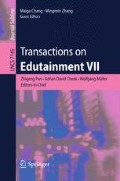Abstract
This paper presents a novel method for realistic simulation of solid objects’ burning. The temperature field is first constructed based on combustion theories. Then, a temperature field motivated interaction model (TFMI) is proposed to simulate the interactions between the fire and the objects during burning. In TFMI, the decomposition of the objects is modeled by improving the level set method and the spreading of fire is calculated using the updated temperature field at each time step. Our method can deal with varied topologies of different objects during burning. The fire is simulated by adopting stable fluid method and integrated into the whole burning scenes. Finally, various solid objects’ burning scenes are rendered automatically using the above model. The experiment results show the validity of our method.
Access this chapter
Tax calculation will be finalised at checkout
Purchases are for personal use only
Preview
Unable to display preview. Download preview PDF.
References
Reeves, W.T.: Particle Systems-a Technique for Modeling a Class of Fuzzy Objects. In: Proceedings of SIGGRAPH, pp. 359–376 (1983)
Pakeshi, A., Yuz, K., Nakajima, M.: Generating Two Dimensional Flame Images in Computer Graphics. IEICE Transactions 74(2), 457–462 (1991)
Hong, Y., Zhu, D., Qiu, X., Wang, Z.: Geometry-Based Control of Fire Simulation. The Visual Computer 26 (2010)
Rushmeier, H.E., Hamins, A., Choi, M.Y.: Volume rendering of pool fire data. In: Proceedings of IEEE Conference on Visualization, pp. 382–385 (1994)
Stam, J., Fiume, E.: Depicting Fire and Other Gaseous Phenomena Using Diffusion Processes. In: Proceedings of SIGGRAPH, pp. 129–136 (1995)
Nguyen, D., Fedkiw, R., Jensen, H.W.: Physically based modeling and animation of fire. In: Proceedings of SIGGRAPH, pp. 721–728 (2002)
Ishikawa, T., Miyazaki, R., Dobashi, Y., Nishita, T.: Visual simulation of spreading fire. In: Proceedings of NICOGRAPH International, pp. 43–48 (2005)
Hong, J., Shinar, T., Fedkiw. R.: Wrinkled flames and cellular patterns. In: Proceedings of SIGGRAPH, pp. 47.1–47.6 (2007)
Yngve, G.D., O’Brien, J.F., Hodgins, J.K.: Animating explosions. In: Proceedings of SIGGRAPH, pp. 29–36 (2000)
Feldman, B.E., O’Brien, J.F., Arikan, O.: Animating suspended particle explosions. ACM Transactions on Graphics 22(3), 708–715 (2003)
Losasso, F., Irving, G., Guendelman, E., et al.: Melting and burning solids into liquids and gases. IEEE Transactions on Visualization and Computer Graphics 12(3), 343–352 (2006)
Melek, Z., Keyser, J.: Interactive simulation of burning objects. In: Proceedings of Pacific Graphics, pp. 462–466 (2003)
Melek, Z., Keyser, J.: Driving object deformations from internal physical processes. In: Proceedings of the ACM Symposium on Solid and Physical Modeling, pp. 51–59 (2007)
Melek, Z., Keyser, J.: Bending burning matches and crumpling burning paper. In: Proceedings of SIGGRAPH Poster (2006)
Liu, S., Liu, Q., An, T., Sun, J., Peng, Q.: Physically based simulation of thin-shell objects’ burning. The Visual Computer 25(5-7), 687–696 (2009)
Osher, S., Fedkiw, R.: Level Set Methods and Dynamic Implicit Surfaces. Springer, New York (2002)
Fedkiw, R.: Geometric Level Set Methods in Imaging, Vision and Graphics. Springer, New York (2003)
Mitchell, I.M.: The flexible, extensible and efficient toolbox of level set methods. Journal of Scientific Computing 35(2-3), 300–329 (2007)
Sethian, J.A.: Level Set Methods and Fast Marching Methods. Cambridge University Press, New York (1999)
Strain, J.: A fast modular semi-lagrangian method for moving interfaces. Journal of Computational Physics 161(2), 512–536 (2000)
Sethian, J.: A fast marching level set method for monotonically advancing fronts. Proceedings of the National Academy of Sciences 93, 1591–1595 (1996)
Hugues, H., Tony, D., Tom, D., John, M., Werner, S.: Surface reconstruction from unorganized points. Computer Graphics 26(2), 71–78 (1992)
Desbrun, M., Meyer, M., Schroder, P., Barr, A.H.: Implicit fairing of irregular meshes using diffusion and curvature flow. In: Proceeding of SIGGRAPH, pp. 317–324 (1999)
Ken, M., David, E.B., Ross, T.W., Alan, H.B.: Level set surface editing operators. In: Proceedings of SIGGRAPH, pp. 330–338 (2002)
Aanaes, H., Baerentzen, J.A.: Pseudo-normal for signed distance computation. In: Proceedings of Vision, Modeling and Visualization, pp. 407–413 (2003)
Author information
Authors and Affiliations
Editor information
Editors and Affiliations
Rights and permissions
Copyright information
© 2012 Springer-Verlag Berlin Heidelberg
About this paper
Cite this paper
Liu, S., An, T., Gong, Z., Hagiwara, I. (2012). Physically Based Simulation of Solid Objects’ Burning. In: Pan, Z., Cheok, A.D., Müller, W., Chang, M., Zhang, M. (eds) Transactions on Edutainment VII. Lecture Notes in Computer Science, vol 7145. Springer, Berlin, Heidelberg. https://doi.org/10.1007/978-3-642-29050-3_10
Download citation
DOI: https://doi.org/10.1007/978-3-642-29050-3_10
Publisher Name: Springer, Berlin, Heidelberg
Print ISBN: 978-3-642-29049-7
Online ISBN: 978-3-642-29050-3
eBook Packages: Computer ScienceComputer Science (R0)

